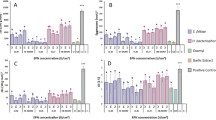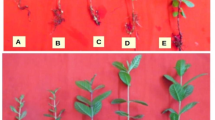Abstract
Carbamate and organophosphate nematicides are routinely used for control of root-knot nematodes (RKN, Meloidogyne spp.) in greenhouses of Crete, Greece. Eleven populations of RKN were collected from greenhouses where such nematicides are intensively applied, but insufficient nematode control has been reported. Their susceptibility to fenamiphos and oxamyl was tested by estimating the percentage of immotile juveniles after 24-h exposure to five concentrations of each nematicide in 3.5-cm Petri dishes. Four populations collected from field crops without any recent history of nematicide application were also included in the study. Three populations maintained in pots for 3, 18 and 20 years without any exposure to nematicides served as controls. The estimation of LC50 and resistant factor values indicated that the nematode populations from greenhouses, despite their intense exposure to nematicides, did not have reduced susceptibility to fenamiphos and oxamyl compared to nematode populations maintained in pots.
Similar content being viewed by others
References
Abbot, W. S. (1925). A method of computing the effectiveness of an insecticide. Journal of Economic Entomology, 18, 265–267.
Chanika, E., Soueref, E., Georgiadou, D., Karas, P., Karanasios, E., Tsiropoulos, N., et al. (2011). Isolation of soil bacteria able to hydrolyze both organophosphate and carbamate pesticides. Bioresource Technology, 102(3), 3184–3192.
Finney, D. J. (1964). Probit analysis. Cambridge: Cambridge University Press.
Giannakou, I. O., Karpouzas, D. G., Anastasiades, I., Tsiropoulos, N. G., & Georgiadou, A. (2005). Factors affecting the efficacy of non fumigant nematicides for controlling root-knot nematodes. Pest Management Science, 6, 961–972.
Karpouzas, D. G., Hatziapostolou, P., Papadopoulou-Mourkidou, E., Giannakou, I. O., & Georgiadou, A. (2004). The enhanced biodegradation of fenamiphos in soils from previously-treated and the effect of soil fumigants. Environmental Toxicology and Chemistry, 23, 2099–2107.
Meher, H. C., Gajbhiye, V. T., Chawla, G., & Singh, G. (2009). Virulence development and genetic polymorphism in Meloidogyne incognita (Kofoid & White) Chitwood after prolonged exposure to sublethal concentrations of nematicides and continuous growing of resistant tomato cultivars. Pest Management Science, 65, 1201–1207.
Papadopoulou, E. S., Lagos, S., Spentza, F., Vidiadakis, E., Karas, P. A., Klitsinaris, T., et al. (2016). The dissipation of fipronil, chlorpyrifos, fosthiazate and ethoprophos in soils from potato monoculture areas: First evidence for the development of enhanced biodegradation of fosthiazate. Pest Management Science, 72(5), 1040–1050.
Pappas, M. L., Migkou, F., & Broufas, D. G. (2013). Incidence of resistance to neonicotinoid insecticides in greenhouse populations of the whitefly, Trialeurodes vaporarium (Hemiptera: Aleyrodidae) from Greece. Applied Entomology and Zoology, 48, 373–378.
Roditakis, E., Skarmoutsou, C., & Staurakaki, M. (2013a). Toxicity of insecticides to populations of tomato borer Tuta absoluta (Meyrick) from Greece. Pest Management Science, 69, 834–840.
Roditakis, E., Skarmoutsou, C., Staurakaki, M., del Rosario Martinez-Aguirre, M., Garcia-Vidal, L., Bielza, P., et al. (2013b). Determination of baseline susceptibility of European populations of Tuta absoluta (Meyrick) to indoxacarb and chlorantraniliprole using a novel dip bioassay method. Pest Management Science, 69, 217–227.
Roditakis, E., Vasakis, E., Grispou, M., Stavrakaki, M., Nauen, R., Gravouil, M., et al. (2015). First report of Tuta absoluta resistance to diamide insecticides. Journal of Pest Science, 88, 9–16.
Rousidou, C., Chanika, E., Georgiadou, D., Soueref, E., Katsarou, D., Kolovos, P., et al. (2016a). Isolation of oxamyl-degrading bacteria and identification of cehA as a novel oxamyl hydrolase gene. Frontiers in Microbiology, 7, 616. doi:10.3389/fmicb.2016.00616.
Rousidou, C., Karaiskos, D., Myti, D., Karanasios, E., Karas, P., Tourna, M., et al. (2016b). Ecology of carbamate hydrolase genes and implications of pH as a driver of the distribution and function of the cehA gene is soils. FEMS Microbiology Ecology, 93, fiw219. doi:10.1093/femsec/fiw219.
Sakuma, M. (1998). Probit analysis of preference data. Applied Entomology and Zoology, 33, 339–347.
Singh, B. K., Walker, A., Morgan, J. A., & Wright, D. J. (2003). Role of soil pH in the development of enhanced biodegradation of fenamiphos. Applied and Environmental Microbiology, 69(12), 7035–7043.
Sparks, T. C., & Nauen, R. (2015). IRAC: Mode of action classification and insecticide resistance management. Pesticide Biochemistry and Physiology, 121, 122–128.
Tzortzakakis, E. A., Anastasiadis, A. I., Simoglou, K. B., Cantalapiedra-Navarrete, C., Palomares-Rius, J. E., & Castillo, P. (2014). First report of the root-knot nematode, Meloidogyne hispanica, infecting sunflower in Greece. Plant Disease, 98(5), 703.
Yamashita, T. T., & Viglierchio, D. R. (1986). In vitro for nonfumigant nematicide resistance in Meloidogyne incognita and Pratylenchus vulnus. Revue de Nematologie, 9(4), 385–390.
Yamashita, T. T., & Viglierchio, D. R. (1987). Field resistance to nonfumigant nematicides in Xiphinema index and Meloidogyne incognita. Revue de Nematologie, 10(3), 327–332.
Yamashita, T. T., Viglierchio, D. R., & Schmitt, R. V. (1986). Response of nematodes to nematicidal applications following extended exposures to subnematicidal stress. Revue de Nematologie, 9(1), 49–60.
Κarpouzas, D. G., Karanasios, E., Giannakou, I. O., Georgiadou, A., & Menkissoglou-Spiroudi, U. (2005). The effect of soil fumigants methyl bromide and metham sodium on the microbial degradation of the nematicide cadusafos. Soil Biology & Biochemistry, 37, 541–550.
Acknowledgements
This research has been co‐financed by the European Union (European Social Fund—ESF) and Greek national funds through the Operational Program “Education and Lifelong Learning” of the National Strategic Reference Framework (NSRF)—Research Funding Program: “THALES. Investing in knowledge society through the European Social Fund”. The collection of nematode populations was assisted by the agronomists A. Thomadakis, G. Troulinakis, D. Stavrianakis, M. Tzortzi and D. Sygelakis. We thank M. Grispou and M. Stavrakaki for computing data for analysis and Dr E. Roditakis for making useful comments on the manuscript.
Author information
Authors and Affiliations
Corresponding author
Rights and permissions
About this article
Cite this article
Tzortzakakis, E.A. In vitro susceptibility of root-knot nematode populations (Meloidogyne spp.) from Crete, Greece to oxamyl and fenamiphos. J Plant Dis Prot 124, 611–616 (2017). https://doi.org/10.1007/s41348-017-0107-7
Received:
Accepted:
Published:
Issue Date:
DOI: https://doi.org/10.1007/s41348-017-0107-7




